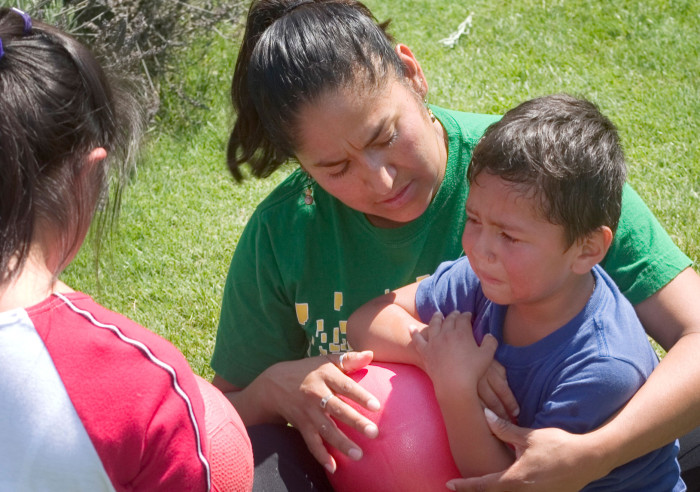In “It's Mine! All About Sharing,” we looked at the “I'll be with you while you wait” policy that helps children when they find themselves in competition for toys or attention. Now, we'll turn to the subject of how you can help a child who tends to take toys away from others, and how to help a child who tends to have things taken away, and can't stand up for himself. Ideas on what to do when you come upon a dispute in full swing are found in this article on When You Get There Too Late
Why children tend to grab
Many children become somewhat tense when they are in close proximity to others and then sharing doesn't come easily. The number of little friendship glitches a child has experienced increases over time, and if he hasn't had anyone listen to him cry until the upset with the other child is gone, upset feelings still sit inside him.
Managing these stored upsets requires a good deal of a child's emotional energy. The more stored tension a child is trying to manage, the more tightly wound he becomes when he's around other children. So he may tend to grab things and fight for things. When he gets what he wants, he may tend to hang on tightly and defensively, spoiling his interactions with others and limiting his own play with his desired toy.
Most adults assume that a child who grabs is expressing his personality, or is in the grip of a habit. The child is labeled “impulsive,” “aggressive,” “strong-willed,” “selfish,” or worse. But a child who tends to grab can become sweet, thoughtful and generous, once the tension he carries is relieved. In other words, what looks like a personality trait or a strong habit is actually just a symptom of tension that is waiting to be relieved. A child is not at fault for his tendency to grab, and neither is his parent. The tension stored inside of him is the real culprit.
You can help a child who tends to grab
When you know that a child has a tendency to grab, you don't have to wait for the blowup between him and another child before you step in to help. In fact, waiting until the problem has exploded has the disadvantage of allowing a tense child to further erode his relationships with other children.
Here are the steps you can take to help a child with the tension that governs his behavior.
- Stop wondering whether he will grab today. Assume that he will. If you know he grabs, it is your job to get there first, so he can't take something from another child. Get close in a warm and friendly way, and stay close. Pay full attention to him in his interactions with others. Move with him as he plays, at most an arm’s length away.
- When he reaches out to grab something from another child, move in and stop his hand before he can grab it. Talk to your child as warmly as you can. Say something like, “That's Suzanne's right now. She'll be finished with it in awhile.” Offer eye contact. Remember that your child, or your child's friend, is a good child.
- If the child is able to make relaxed eye contact with you, and can decide to move on to something else to play with, he's in OK shape for the moment. Continue to stay close in case the tension you usually see surfaces later.
- If the child squirms, runs away, protests, or starts a tantrum, stay and reassure him that it will be his turn eventually, and that you'll help him wait. He'll use the limit you've kindly set, and the attention you offer him, to offload frustration or sadness or fear. Perhaps he misses his Mommy. Perhaps he doesn't feel sure that he'll see his Daddy tonight. Perhaps he feels he doesn't know how to make friends. There are an infinite number of underlying feelings that could be causing his inability to be thoughtful of other children.
- Listen well while he cries or tantrums. He will tell you, verbally or nonverbally, what the underlying feelings are. You may hear, “I never get what I want,” “I want to go home,” or “I don't like Johnny.” None of these feelings are wrong. As you listen, you help your child to undo the power these feelings have over his behavior. You can show that you're on his side by saying, “I'll help you get what you want, we just need to wait until Johnny’s finished.” Listen as long as you can.
- After a hearty cry or a tantrum, you will see a marked change in a child’s ability to be flexible in play. His tensions have dissolved, and he's able to make choices that more accurately reflect his desire to be friends and play cooperatively. If he wasn't able to do more than a couple of minutes of crying, he may look miserable and keep trying to find reasons to initiate the crying or tantrums again. He wants to finish the job he started, with the support and understanding of a thoughtful adult.
You can help a child who goes passive when someone takes his things

A child who goes passive when someone takes his things carries tensions, too, but the effect on his behavior is quite the opposite. He is afraid, but his fear makes him go passive instead of active. Sometimes, the same kind of hurt lies behind a passive child's behavior and behind the behavior of an impulsive child. We don't really know why one child lands in the passive role, and another is tied to the aggressive role. Fortunately, the reasons don't matter much. The solution is the same whatever the hurt. Children instinctively know how to offload tension, and we adults simply need to support them as they do it.
When something is taken from a child with passive tendencies, he may signal his upset right away by whining or beginning to cry. Most adults will at that point try to mediate the difficulty. They'll scold the child who grabbed, or demand that the whining stop, or tell the children to “use their words.” These interventions are common and understandable, but the good they do is only cosmetic. They may make things look better on the surface, but they're not especially helpful in relaxing an impulsive child or empowering a child who wilts.
Some children feel so helpless, they can't even begin to whine or cry. When something is taken away, they simply look sad, and show no ability to protest. Adults will often miss the fact that there is a difficulty here, and be glad for the lack of upset. If you wonder whether a child is quietly upset but can't imagine standing up for himself, you can move in close and ask, “Did you want that toy?” or “Do you wish you could have a turn? I'll help you if you want to.” This will give him the attention he needs to notice his feelings and respond.
To resolve the difficulty, take a long-term approach
If you have a child who easily becomes trapped in feeling helpless, no single intervention will change all of the internal feelings that weigh so heavily when he is challenged. What will work is a policy of encouragement, combined with listening.
Here are the steps you can take that will lead to a child's increased ability to take charge, say what he wants and needs, and hold his own with other children in play.
- When you can, prevent the child who tries to grab from taking the toy. Don't grab it yourself. Simply put your hand on the toy, so it can't be pulled away. Tell the child who wants it, “You can play with this when Maria is through with it.” This will probably allow him to begin crying and start releasing the tensions that are plaguing him.
- If the impulsive child is still pulling, continue to hold the item, and encourage the more passive child to hold on too. The reassurance that he has permission to assert his hold on the item will often help a child move out of the passivity that leaves him acting helpless. He gets to use his power, and he may cry while he tugs at the toy. Crying and fighting for himself is progress for him, so allow him to pull. Tell him, “You’ll be able to have it soon. Sally needs to let go. She will. I promise.”
- Listen to both children until there is a natural resolution that evolves. Both children need the chance to work on their feelings. One needs to work on his feelings of urgency, and the other needs encouragement to try hard for what he wants. You keep things safe for both, so neither can insult the other, or “win” in the contest of wills. With your listening, the children will get to a point where they can work out a solution. Emotional healing gets done, instead of relationship damage.
- With repeated encouragement to take charge, and repeated chances to cry about not feeling powerful, a child will make definite and visible gains in his sense of his power. Eventually, he won't need your coaching. He'll know what to do, because his mind has been cleared of the confusion caused by earlier experiences that frightened or overwhelmed him.
- You can increase your own flexibility when sharing difficulties arise. Most adults are impulsive and many are harsh when they handle sharing difficulties between children. The Parenting by Connection approach outlined above is highly effective, but it requires both time and presence of mind, two things often in short supply for busy, overburdened parents. Without some way to renew your inner resources, it won't be easy to help your children and their friends over the bumps in their relationships.
We strongly recommend starting a Listening Partnership with another parent (join our Parent Club Community to find one), so that your needs for thinking time and stress release are met on a regular basis. All it takes is the courage to ask another parent whether he or she would be willing to exchange listening time. No equipment is needed. There's no fee to pay. The time and place is of your choosing—we recommend a quiet room separate from the hubbub of the household.
It's surprising how much stress a half-hour of listening can relieve! And it's interesting to come in contact with the superb workings of your own mind, which will lead you toward just the right things to talk about, even if you have no idea ahead of time what those are.
Find more information on how to do this here.
Learning to help children who are impulsive and children who wilt will give you power and experience in helping young people in ways you hadn't imagined you could. Invest in listening and being listened to, so that you can evaluate your experiences and move steadily forward as a nurturer and a parent.

